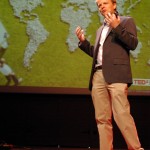Jan23
Workforce Innovation: How Txteagle Distributes Microtasks Worldwide
Point: Dividing work into microtasks and using software to manage quality enables outsourcing of work directly to billions of workers worldwide
Story: One month after launching in Kenya, startup Txteagle Inc became one of the country’s largest employers with a workforce of 10,000 Kenyans. Let’s look at what Txteagle does and the implications for managers and employees worldwide.
In 2008, former MIT Research Scientist Nathan Eagle founded Txteagle (now Jana Mobile), with the idea of marrying crowdsourcing to cellphones. Txteagle deconstructs work into microtasks that can be performed on any simple mobile phone through texting. Txteagle distributes the microtasks to thousands of workers (currently primarily in Africa) who complete them and get paid via the mobile phone either in airtime minutes or in cash through the M-Pesa service.
“Txteagle is a commercial corporation that enables people to earn small amounts of money on their mobile phones by completing simple tasks for our corporate clients,” says Eagle.
The types of tasks Txteagle’s African workers have done are:
* enter details of local road signs for creating satellite navigation systems
* translate mobile-phone menu functions into the 62 African dialects (for Nokia)
* collect address data for business directories
* fill out surveys for international agencies
Txteagle seems similar to Amazon’s Mechanical Turk, except that workers only need a simple mobile phone – no computer or Internet access is needed. TxtEagle now has partnerships with 220 mobile operators in more than 80 countries. This expands Txteagle’s reach to 2.1 billion cellphone users in sub-Saharan Africa, Brazil and India, who can all participate as workers. Currently, the firm earns revenues 49 countries.
At first glance, managing 10,000+ workers — not to mention controlling quality — seems daunting. Txteagle solves the problem through algorithms. “Instead of using managerial staff to oversee accuracy and quality, we use math,” Eagle says. Txteagle’s algorithms infer the correct answer by asking more than one person, Eagle said. Txteagle also tracks each worker’s accuracy and rewards the best workers. “If they get a lot of right answers in a row, we pay them more for each answer,” Eagle says.
Win/win/win/win for everyone:
For companies in the developed world:
* lowers labor costs through access to a worldwide workforce
* access real-time local expertise in language, business, markets, and conditions
For developed-world workers
* make extra money during downtime
* flextime work
For developing-world workers
* access to work despite local economic conditions
* lets women work remotely
Entrepreneurs everywhere have to opportunity to design work in a new way and not need employees on the payroll in order to get work done.
Action
- Think about the information that ordinary people in foreign markets could collect for your business, such as market conditions, surveys, local business prospects
- Consider overcoming language hurdles that keep your products from succeeding in diverse economies
- Think about tasks anyone in the world might do during a few minutes to spare
- Imagine how 2.1 billion people could work for you one text at a time
Sources:
Txteagle (now Jana Mobile)
Jessica Vaughn, “Q&A: Nathan Eagle, founder of txteagle,” JWT Intelligence March 3, 2010 http://www.jwtintelligence.com/2010/03/qa-nathan-eagle-founder-of-txteagle/
Robert Bain, “The power of text in the developing world,” 20 January 2011 http://www.research-live.com/features/the-power-of-text-in-the-developing-world/4004395.article
Kate Greene, “Crowd-Sourcing the World,” MIT Tech Review, Jan 21, 2009 http://www.technologyreview.com/business/21983/
Nathan Eagle presentation at TedxBoulder, August 7, 2010









